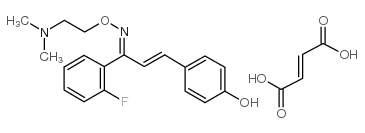Eplivanserin hemifumarate

Eplivanserin hemifumarate structure
|
Common Name | Eplivanserin hemifumarate | ||
|---|---|---|---|---|
| CAS Number | 130580-02-8 | Molecular Weight | 444.45300 | |
| Density | N/A | Boiling Point | 456.3ºC at 760mmHg | |
| Molecular Formula | C23H25FN2O6 | Melting Point | N/A | |
| MSDS | Chinese USA | Flash Point | 229.8ºC | |
| Symbol |


GHS07, GHS09 |
Signal Word | Warning | |
|
Nest building is impaired in the Ts65Dn mouse model of Down syndrome and rescued by blocking 5HT2a receptors.
Neurobiol. Learn. Mem. 116 , 162-71, (2014) Down syndrome (DS) has an incidence of about 1/700 births, and is therefore the most common cause of cognitive and behavioral impairments in children. Recent studies on mouse models of DS indicate that a number of pharmacotherapies could be beneficial for res... |
|
|
Role of serotonin (5-HT)2 receptors in cocaine self-administration and seeking behavior in rats.
Pharmacol. Rep. 57(1) , 35-46, (2005) Previous studies have indicated a role of serotonin (5-HT)2 receptors in modulation of the behavioral effects of cocaine. In the present study, the efficacy of SR 46349B (a 5-HT(2A) receptor antagonist) or SDZ SER-082 (a 5-HT(2C) receptor antagonist) in alter... |
|
|
Activation of slowly conducting medullary raphe-spinal neurons, including serotonergic neurons, increases cutaneous sympathetic vasomotor discharge in rabbit.
Am. J. Physiol. Regul. Integr. Comp. Physiol. 288(4) , R909-18, (2005) Neurons in the rostral medullary raphe/parapyramidal region regulate cutaneous sympathetic nerve discharge. Using focal electrical stimulation at different dorsoventral raphe/parapyramidal sites in anesthetized rabbits, we have now demonstrated that increases... |
|
|
The role of serotonin-2 (5-HT2) and dopamine receptors in the behavioral actions of the 5-HT2A/2C agonist, DOI, and putative 5-HT2C inverse agonist, SR46349B.
Psychopharmacology 213(2-3) , 393-401, (2011) Atypical antipsychotic efficacy is often attributed to actions at serotonin-2 (5-HT(2)) and dopamine receptors, indicating a potential benefit of understanding the interplay between these systems. Currently, it is known that 5-HT(2) receptors modulate dopamin... |
|
|
Anxiolytic-like effect of milnacipran in the four-plate test in mice: mechanism of action.
Pharmacol. Biochem. Behav. 81(3) , 645-56, (2005) Milnacipran is a serotonin/noradrenaline reuptake inhibitor (SNRI) which has not yet been systematically studied preclinically or clinically for the treatment of anxiety disorders. In the four-plate test (FPT) which is known to predict anxiolytic-like activit... |
|
|
Regulation of striatal neuropeptide mRNAs: effects of the 5-HT(2) antagonist SR46349B in adult rats with a neonatal 6-hydroxydopamine lesion.
J. Neurosci. Res. 67(1) , 86-92, (2002) The intrastriatal injection of 6-hydroxydopamine (6-OHDA) in newborn rats produces a marked striatal dopamine (DA) depletion, accompanied by a serotonin (5-HT) hyperinnervation and an up-regulation of 5-HT receptors. The aim of the present study was to invest... |
|
|
Structural combination of established 5-HT(2A) receptor ligands: new aspects of the binding mode.
Chem. Biol. Drug Des. 76(4) , 361-6, (2010) MH.MZ, MDL 100907, and altanserin are structurally similar 4-benzoyl-piperidine derivatives and are well accommodated to receptor interaction models. We combined structural elements of different high-affinity and selective 5-HT(2A) antagonists, as MH.MZ, alta... |
|
|
Blockade of 5-HT2A receptors suppresses hyperthermic but not cardiovascular responses to psychosocial stress in rats.
Neuroscience 159(3) , 1185-91, (2009) The aim of this study was to determine whether 5-HT2A receptors mediate cardiovascular and thermogenic responses to acute psychological stresses. For this purpose, adult male Wistar hooded rats instrumented for telemetric recordings of either electrocardiogra... |
|
|
3,4-methylenedioxymethamphetamine (MDMA, ecstasy)-induced egr-1 mRNA in rat brain: pharmacological manipulation.
Eur. J. Pharmacol. 402(3) , 215-22, (2000) Using in situ hybridization and immunohistochemical techniques, we examined the expression pattern of egr-1 mRNA and Egr-1 protein in several brain regions following administration of 3, 4-methylenedioxymethamphetamine (MDMA). Furthermore, we also studied the... |
|
|
Spinal 5-HT2A receptors regulate cutaneous sympathetic vasomotor outflow in rabbits and rats; relevance for cutaneous vasoconstriction elicited by MDMA (3,4-methylenedioxymethamphetamine, "Ecstasy") and its reversal by clozapine.
Brain Res. 1014(1-2) , 34-44, (2004) We determined whether spinal 5-hydroxytryptamine 2A (5-HT2A) receptors contribute to resting cutaneous sympathetic vasomotor activity, and to increases in activity elicited by electrical stimulation of the medullary raphe/parapyramidal region, and whether the... |